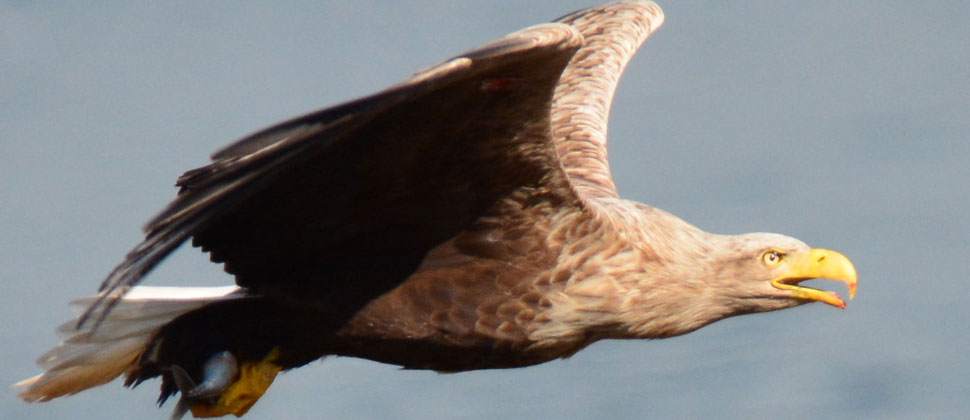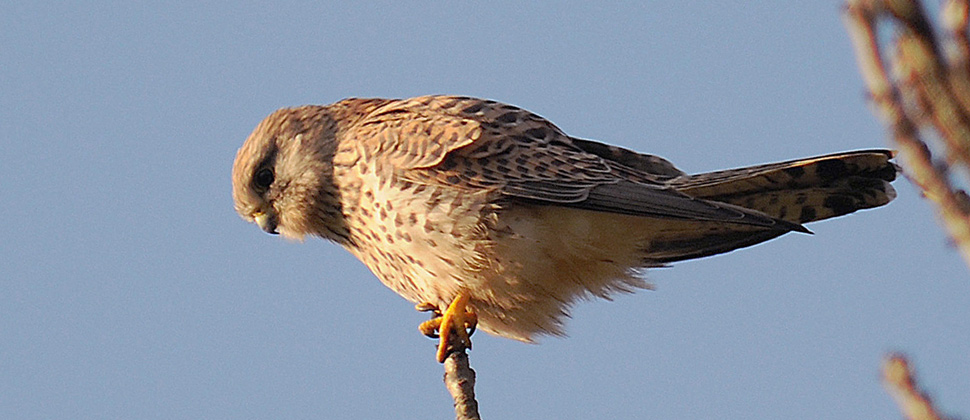News
15 November 2013
A new paper has just been published that reveals new insights into the dispersal behaviour of young golden eagles in Scotland. The study examined satellite tag data from 24 young golden eagles, tagged between 2007-2010 in 20 different home ranges. The results show that the majority of these eagles stayed in their parents’ territory for some considerable time after fledging, even though they made short, temporary excursions (up to 44km) before eventually dispersing for good. The authors suggest that these temporary excursions may help the young birds to decide when they should ‘properly’ leave and where might be the best place to go when they do leave. The study forms part of a PhD being undertaken by North East Raptor Study Group member Ewan Weston.
Weston, E.D., Whitfield, D.P., Travis, J.M.J. and Lambin, X. (2013). When do young birds disperse? Tests from studies of golden eagles in Scotland. BMC Ecology 13: 42.
The full paper is available to download here.
13 November 2013
The RSPB has published its annual report on bird crime in the UK for 2012. The country’s worst area for crimes against birds of prey is North Yorkshire where 34 incidents were reported. Aberdeenshire is the second worst area with 31 reported raptor crimes. The RSPB’s press release can be read here and the report can be downloaded here.
12 November 2013
Researchers have been collecting information about day-time-calling Tawny Owls across the UK and are now making a final appeal for information as their survey will close on 28th February 2014. They are particularly interested in receiving records from Scotland. For further details of the survey and who to contact if you can help, please click here.
A leading upland ecologist has warned of ‘massive declines’ of mountain hares on grouse moors around Deeside and claims it is a ‘national scandal’. In an article published in the Sunday Herald, Dr Adam Watson, who is also a founding member of the North East Raptor Study Group, says in some areas the hares have been completely wiped out and blames SNH for failing to protect the species under European law. His claims are supported by other members of the Scottish Raptor Study Group, as well as by the RSPB. Landowners insist that the mountain hare population is ‘stable and robust’. However, SNH has admitted that there might have been localised extinctions but is unable to accurately assess the status of the national mountain hare population due to surveying difficulties. To read the article please click here.
7 November 2013
Red kite conservation efforts began in earnest in 1989 when the RSPB and SNH initiated a reintroduction project to restore this native species to its former range. Those efforts continue although now the focus is firmly on monitoring the species’ fortunes in the face of continuing persecution. This monitoring effort is undertaken largely by the RSPB and members of the Scottish Raptor Study Group, with almost complete coverage of the entire red kite population in Scotland.
The results of the 2013 red kite breeding season have now been tallied and show that the kites are doing well with a total of 252 known territorial pairs. Of these, 180 pairs bred successfully in 2013 and between them they produced 335+ fledglings. The regional breakdown is as follows:
Northern Scotland: 49 successful pairs, 105 fledged.
Central Scotland: 52 successful pairs, 96+ fledged.
Dumfries & Galloway: 63 successful pairs, 91+ fledged.
Aberdeen: 16 successful pairs, 43 fledged.
2013 was also an important year for two public red kite viewing facilities (Argaty Red Kites near Doune and the Galloway Red Kite Trail near Castle Douglas) as they celebrated their tenth annniversaries. More info here.
5 November 2013
The 2012 Report of the Scottish Raptor Monitoring Scheme has just been published and is available for download from our website.
The award-winning Scottish Raptor Monitoring Scheme was established in 2002 to improve partnership working between organisations involved in raptor monitoring in Scotland. There are currently eight partners in the scheme: Scottish Raptor Study Group, RSPB Scotland, British Trust for Ornithology, Scottish Natural Heritage, Joint Nature Conservation Committee, Rare Breeding Birds Panel, Scottish Ornithologists’ Club and Forestry Commission Scotland.
These annual reports provide an unprecedented picture of raptor population trends across Scotland and are essential to help researchers, government officials etc to monitor the conservation status of our birds of prey.
To download the 2012 report please click here.
1 November 2013
The magnificent golden eagle has been voted Scotland’s favourite wild animal in a poll that saw it competing against other iconic species such as the otter, red squirrel, red deer and harbour seal. Over 12,000 votes were cast and the golden eagle was a clear winner, securing over 4,000 votes in comparison to the second-placed red squirrel with over 2,000 votes. Environment Minister Paul Wheelhouse commented that although Scotland holds the UK’s entire golden eagle breeding population, recent incidents have shown that the species still faces considerable threats in some parts of the country. Long-term and on-going research by SRSG members and others shows that golden eagles are still routinely poisoned, trapped or shot on driven grouse moors in central, esatern and southern Scotland. BBC news here.
30 October 2013
It will now be easier for people to report suspected bird strike incidents (e.g. collisions with wind turbine blades) as Scottish Natural Heritage launches a dedicated email address. If you suspect a bird has collided with a wind turbine, you can email details such as location, date and bird species to: Collision.Records@snh.gov.uk. For further details the BBC news article is here.
22 October 2013
Scientists tracking the dispersal movements of a young hen harrier from the Langholm Moorland Demonstration Project have expressed ‘serious concerns’ about his safety after his satellite signal unexpectedly stopped transmitting. The young male, called Blue, was one of four young harriers being tracked from Langholm this year. Project staff say the matter has now been passed on to the police. More information here.
15 October 2013
A young hen harrier from the Langholm Moorland Demonstration Project has surprised everyone by flying across the sea to Ireland, via the Isle of Man. Miranda’s movements are being monitored by scientists who have attached a satellite tag to her back. Her movements are also being followed by the general public who are watching her ‘movement maps’ here.
Archive:
2015
- February,
- January,
2014
- December,
- November,
- October,
- July,
- June,
- May,
- April,
- March,
- February,
- January,
2013
- December,
- November,
- October,
- September,
- August,
- July,
- June,
- May,
- January,
2012
- December,
- November,
- October,
- September,
- August,
- July,
- June,
- May,
- April,
- March,
- February,
- January,





